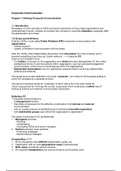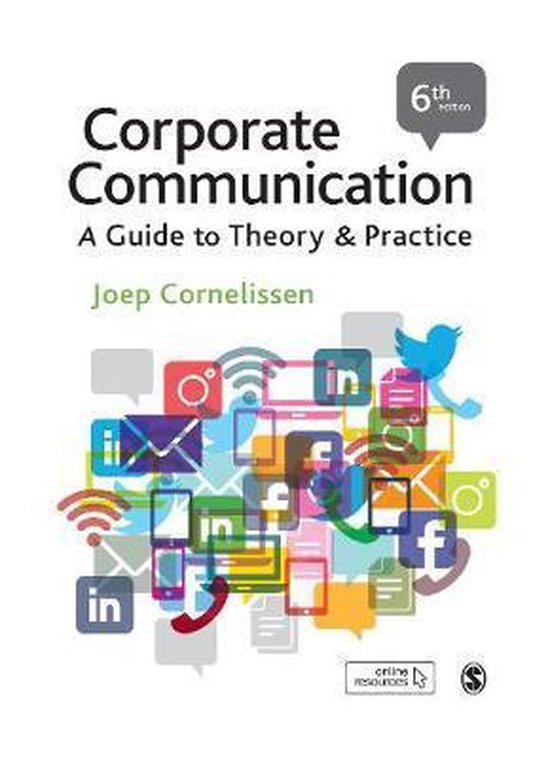Corporate Communication
Chapter 1: Defining Corporate Communication
1.1 Introduction
Nowadays, it’s the core task of CEOs and senior executives of many large organizations and
multinationals to build, maintain and protect the company’s corporate reputation, especially after
the globalization and crises.
1.2 Scope and definitions
Until the 1970s, it was called Public Relations (PR) to describe communication with
stakeholders.
- Tactical support.
- Largely consisted of communication with the press.
After the 1970s, other stakeholders demanded more information from the company and it
became something more than just ‘public relations’ —> it became CC.
It got a much broader focus:
- It is holistic: it focuses on the organization as a whole (this also distinguishes CC from other
professional forms of communications within organization, such as business/management
communication, which focus on small groups within the organization).
- Stakeholder presentation: how an organization presents itself to all its key stakeholders
(internal and external).
This broad focus is also reflected in the word ‘corporate’, as it refers to the business setting in
which CC emerged as a separate function.
The second important sense for ‘corporate’ is that it stems from the Latin words for
‘body’ (corpus) and for ‘forming into a body’ (corporare) which emphasize a unified way of
looking at internal and external communication disciplines.
Definition CC
‘’Corporate communication is…
- a management function
- that offers a framework for the effective coordination of all internal and external
communication
- with an overall purpose of establishing and maintaining favorable reputations
- with stakeholder groups upon which the organization is dependent.’’
Two types of activities of CC professionals:
1. Managerial activities
- Planning
- Coordinating
- Counseling CEOs and senior managers
2. Tactical activities: more practical
- Producing messages
- Disseminating messages
Complexities of CC:
1. All the disciplines have different stakeholders, goals, etc.
2. Organization with an wide geographical range (multinationals)
3. Wide range of products and/or services
4. All corporate headquarters and various divisions and business units
,Range of disciplines of CC
Corporate advertising Corporate design Employee communication
Issue and crisis management Media relations Investor relations
Change communication Public affairs Etc.
Key concepts in CC
Concept Definition
Mission The overall purpose of the company.
Who are we? & What do we value?
Vission The desired future state of the organization.
What do we want to become?
Corporate objectives The overall aims, which are in line with the overall
purpose.
How do we determine our degree of success?
Strategy The ways or means in which the objectives are
achieved.
How will we achieve our vision/objectives?
——————————————————————— ———————————————————————
Corporate identity The profile and values an organization wants to
project on stakeholders.
‘The world’s favorite airline’
Corporate image The immediate set of associations of an individual
stakeholder in response to signals from or about
the organization at a single point in time.
‘Recently, I booked a ticket to London, and the BA
staff wasn’t very nice to me.’
Corporate reputation An individual’s collective representation of past
images of an organization established over time.
——————————————————————— ———————————————————————
Stakeholder Any group or individual who can affect/is affected
by the achievement of the organization’s objectives.
Relevant person/group: employees, investors,
consumers, shareholders, community, society…
Market A defined group for whom a product/service is in
demand/created.
——————————————————————— ———————————————————————
Communication The media and tactics that are used to
communicate with internal and external groups.
Integration The act of coordinating all communication so that
the corporate identity is communicated to
stakeholder groups.
,1.3 Trends in corporate communication
1980s
- Before the 1980s: fragmentation led to each department sub optimizing their own
performance.
- In the 1980s: the restructuring trend in CC. Many separate communication disciplines were
brought together into more integrated departments or into specific working practices.
- The realization that strategic positioning was needed for stakeholders.
—> This all led to consolidated departments (they ‘merged’).
1990s - 2000s
Organizations became concerned with the following ideas…
- Corporate branding
- Corporate identity
- Corporate reputation
—> Which emphasized the importance of positioning: strategically putting your brand into the
minds of important stakeholder groups.
The downside of this was that the thought came up that a stakeholders mind could be
controlled/managed. This would led up to an uncomplicated process of sending and receiving
messages where any outcomes are already largely predetermined or given.
- It suggested that stakeholders were passive agents, which basic role is to respond to the
communicator’s message, where in fact, they were active agents.
- It also suggests a linear (a ‘conduit’) model of communication, as opposed to seeing
communication as a joint activity.
2010s - present
Stakeholders became much more active: voicing, self-organizing, advocating.
They also have more media wisdom than before, so an organization has to be credible.
They are empowered by new media technologies, which are interactive & dialogue-based
—> stakeholders share more personal experiences, opinions, ideas about organizations.
This offers challenges & opportunities to organizations because of:
- Electronic word-of-mouth (eWOM)
- Peer-to-peer influence (when individuals self-organize)
Communication as
tactical support
—> Communication as
strategic tool
Organizations have to be
transparent & have
authenticity.
Advocacy & interactivity
are also necessary for
strong stakeholder
relations.
, Chapter 2: Corporate Communication in Contemporary Organizations
Marketing communication is product or service related, aimed to the needs of the consumer/
customer while making a profit.
PR deals with wider public, excluding the consumer/customer. It doesn’t interfere with profit-
making, it rather supports the company.
2.1 Historical developments
1. Industrial Revolution: mass production/consumption.
—> Increased competition between firms
—> Rise of marketing communications
2. Muckraking journalism: exposed scandals involving capitalism, power and government
corruption. They raised the awareness of unethical practices.
Organizations hired these journalists as spokespeople.
—> Rise of public relations.
3. Economic depression: they became skeptical of big companies because of the great crises.
—> Development of expertise on PR and marketing.
—> PR and marketing started to emerge as separate external disciplines.
4. Integration of M & PR under the umbrella of CC (Kotler & Mindak, in the 1980s).
—> Rise of branded content.
2.2 Integrated Communication
Model A: distinct disciplines.
Traditional view, up until the
1980s.
‘Marketing deals with
markets, whilst PR deals with
all the publics of an
organization (excluding
customers and consumers)’.
Model B: Complementary
disciples (some common
ground).
MPR came up.
Model C: PR = part of M.
Example: IMC, where PR is
reduced to activities of
product publicity and
sponsorship, ignoring its
wider remit in communicating
to employees etc.
Model D: M = part of PR.
- The role of M to satisfy customers is seen as only part of a wider public relations effort, only to
satisfy the multiple publics and stakeholders of an organization.
Model E: Fully integrated disciplines.
‘Marketing Public Relations’ (MPR): the publicizing of news and events related to the launch and
promotion of products/services. MPR involves the use of PR techniques for marketing purposes.





